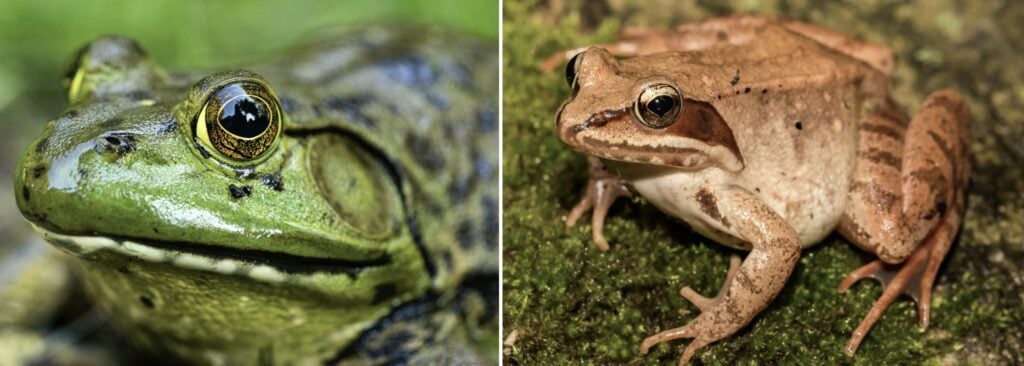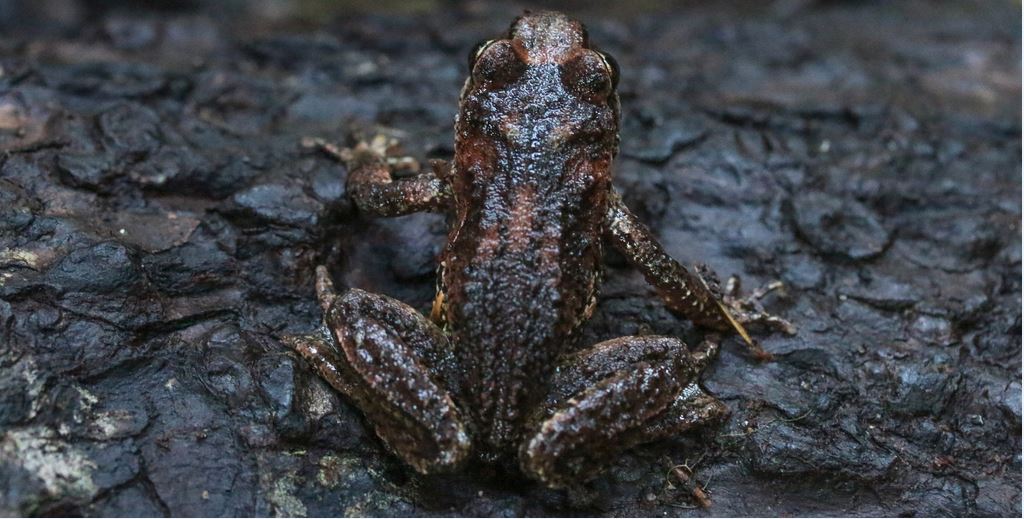9 Types of Frogs Found in Oregon! (ID Guide)
“What kind of frogs can you find in Oregon?”

I love finding, observing, and hearing frogs!
Even as a kid, I used to patrol the swamps by my house, catching them and then trying to sell them as pets to cars passing by. As you can imagine, no one was interested in buying my frogs, and I ended up letting them go at the end of each day. 🙂
Today, I’m providing a guide to teach you about the different kinds of frogs found in Oregon.
One of the BEST ways to find frogs is to learn the noises they make. So, in addition to pictures, you will find audio samples for each species below!
9 Frog Species in Oregon:
-
RELATED: 11 Common SNAKES That Live in Oregon! (ID Guide)
-
RELATED: What Are The 7 Types of TURTLES Found in Oregon?
-
RELATED: 3 Types of Toads Found in Oregon! (ID Guide)
#1. American Bullfrog
- Lithobates catesbeianus

Identifying Characteristics:
- Adult body lengths range from 3.6 to 6 inches.
- Coloration is typically olive green, with some individuals having gray or brown mottling or spots.
- Fully webbed back feet.
The American Bullfrog is the largest frog in Oregon!
Believe it or not, they can grow to weigh as much as 1.5 pounds (.7 kg). Unfortunately, these massive frogs are not native to Oregon and were introduced from the eastern half of the country. Their giant appetites can be incredibly destructive to native ecosystems.
American Bullfrog Range Map

Green = native range. Red = introduced range.
Bullfrogs can be found in permanent bodies of water, including swamps, ponds, and lakes. During the breeding season, the male frogs select egg sites in shallow waters, which they defend aggressively. A female will then select a male by entering his territory.
They are named for their deep call, which is thought to sound like a bull bellowing.

Bullfrogs are known to eat just about anything they can fit in their mouth and swallow! The list of prey includes other frogs, fish, turtles, small birds, bats, rodents, insects, crustaceans, and worms. I have personally witnessed one even trying to eat a baby duck!
#2. Northern Leopard Frog
- Lithobates pipiens

Identifying Characteristics:
- Adults range from 2 to 4.5 inches long.
- Smooth skin is green, brown, or yellow-green with large dark spots.
- Lighter-colored raised ridges extend down the length of the back.
You can spot Northern Leopard Frogs in Oregon near slow-moving bodies of water with lots of vegetation. You might see them in or near ponds, lakes, streams, and marshes. I love how bright green most individuals appear!
Northern Leopard Frog Range Map

Due to their fairly large size, these frogs eat various foods, including worms, crickets, flies, and small frogs, snakes, and birds. In one study, a bat was even observed being eaten!
During the spring breeding season, the males will float in shallow pools emitting a low call thought to sound a bit like snoring. The Northern Leopard Frog may also make a high, loud, screaming call if captured or startled.

Northern Leopard Frog populations are declining in many areas, and the cause is not exactly known. It’s thought to be some combination of habitat loss, drought, introduced fish, environmental contaminants, and disease.
#3. Pacific Treefrog
- Pseudacris regilla

Identifying Characteristics:
- Adults can reach 2 inches long, with the males typically being smaller.
- Most are green or brown with pale white undersides, but some are reddish, gray, cream, or black.
- Dark mask across the eyes to the shoulders and uniformly bumpy skin.
The Pacific Treefrog can be found in a wide range of elevations in Oregon, ranging from sea level to 10,000 feet (3,050 m)!
Pacific Treefrog Range Map

Look for them in woodlands and meadows. Interestingly, these frogs spend most of their time on the ground despite being a treefrog. They even hide from predators in underground burrows!
The Pacific Treefrog travels to the shallow water of ponds and lakes to breed and lay eggs. The female attaches the eggs to sticks or other underwater debris.
Also called the Pacific Chorus Frog, this species can be heard during the spring.

Their mating call is a two-part call that sounds like “kreck-ek” or “rib-bit.“
#4. Coastal Tailed Frog
- Ascaphus truei
Identifying Characteristics:
- Adults are 0.9 to 2.1 inches long.
- Rough skin with a coloration of brown to olive green. Large, flattened head with a light triangular mark between the snout and eyes.
- Slightly webbed hind feet, hard toe tips, and the males have a tail-like extension of their cloaca.
This species might be the most unique frog in Oregon!
Coastal Tailed Frog Range Map

Unlike most other species, the Coastal Tailed Frog is found in steep, fast-moving, rocky streams. This habitat has caused this species to develop several unique adaptations.
They have reduced lung size, likely to control buoyancy, and hard toe tips to help them travel along the bottom of these streams. They also have a greater number of vertebrae than other frogs. Lastly, these frogs lack ear membranes, which means they CAN’T vocalize.
Tailed frogs get their name from a unique habitat adaptation, the male frog’s cloacal extension. This extension is used to insert sperm into the female so it isn’t lost in the fast-moving water. They are the only North American species of frog to reproduce through internal fertilization.
The females lay strings of eggs under rocks in the stream. The tadpoles have a large oral sucker which allows them to attach themselves to smooth stones in turbulent water. It takes the tadpoles one to four years to mature into adult frogs.
#5. Cascades Frog
- Rana cascadae

Identifying Characteristics:
- Adults range from 1.5 to 3 inches long.
- Typically green or brown with dark gray or black spots on their back.
- Small bumps on their back and sides, a dark mask, and a white jawline stripe extending to the shoulders.
This frog is named for where it was first discovered, which is the Cascade Mountains! They’re typically found in ponds, lakes, marshes, or slow-moving streams between 2,182 and 8,038 ft (665 and 2,450 m) in elevation.
Cascades Frog Range Map

The males make a breeding call during the day and night from above and underwater. Listen for a sound that is a series of low, chattering, grating, and clucking noises.
You may spot their bicolored eggs, which are black on top and white on the bottom, floating in masses near the shore. Tadpoles mature in 3-4 months, depending on the water temperature.
Interestingly, the skin of Cascades Frogs secretes an antimicrobial substance that helps protect them from pests and infections. Talk about self-healing!
#6. Northern Red-legged Frog
- Rana aurora

Identifying Characteristics:
- Adult body lengths range from 2 to 5.25 inches, with the females being larger.
- Reddish-brown to gray with dark specks and blotches, dark mask, and light stripe on the jaw.
- Yellow underside with red on the lower abdomen and hind legs.
The Northern Red-legged Frog is typically found in Oregon near slow-moving streams and ponds. They prefer shaded areas with plenty of emergent vegetation, which they use as defense from predators.
Northern Red-legged Frog Range Map

These frogs require cool water temperatures to reproduce, so the breeding season begins early, between January and March. The males select territories and produce a soft mating call with 5-7 repeating notes sounding a bit like, “uh-uh-uh-uh-uh.” They make this call both under and above water.
The females produce large egg masses, which they attach to rotting logs and submerged vegetation typically 5 to 6 inches below the water surface. Believe it or not, Northern Red-legged Frogs can live for 12 to 15 years!
#7. Foothill Yellow-legged Frog
- Rana boylii

Identifying Characteristics:
- Adult body lengths range from 1.5 to 3.2 inches.
- Coloration is gray, brown, or olive green, sometimes with darker mottling and a buff triangular patch on the snout.
- Granular skin and yellow underside of hind legs and lower abdomen.
The Foothill Yellow-legged Frog can be found up to 6700 feet above sea level on the western slopes of the Cascade and Sierra mountain ranges. Look for them in Oregon in rocky streams and rivers with open, sunny banks.
Foothill Yellow-legged Frog Range Map

Sadly, this frog has disappeared from much of its range. It faces threats from habitat loss from dams and polluted waters from agricultural pesticides.
Unlike many frogs, the male’s breeding call is rarely heard. They produce a series of 4-6 low-pitched, raspy notes and predominately call underwater and at night. The females attach egg masses to the downstream side of submerged rocks and pebbles in slow-moving streams. The tadpoles become adult frogs in roughly 3 to 4 months.
Interestingly, Foothill Yellow-legged Frogs secrete a unique substance through their skin which is key to helping prevent fungal infections!
#8. Sierran Tree Frog
- Pseudacris sierra

Identifying Characteristics:
- Adults can reach 2 inches long, with males typically being smaller.
- Dark mask across the eyes to the shoulders and uniformly bumpy skin.
Sierran Tree Frogs are mainly found in Oregon in forests.
Adults typically appear as shades of either brown or green. But interestingly, individuals can change colors over the course of a few hours to help them blend into their environment. So if you find one and come back to find it later, it may look completely different. 🙂
The Sierran Tree Frog has an interesting, if not confusing, history. These frogs used to be known as Pacific Tree Frog (Pseudacris regilla), but in 2006, a scientific paper came out that split Pseudacris regilla into three species:
- Pacific Tree Frog (Pseudacris regilla), Baja California Tree Frog (Pseudacris hypochondriac), and the Sierran Tree Frog.
Unfortunately, the paper did not provide any way to tell the difference between these three species, nor any maps as to where each one is primarily found. While this change has been controversial, it has stuck over the years.
#9. Columbia Spotted Frog
- Rana luteiventris

Identifying Characteristics:
- Green or brown with black spots on its back
- The upper lip and belly are white.
- Compared to other frogs, they have shorter back legs, upturned eyes, and a narrower snout.
You will almost always find Columbia Spotted Frogs near permanent bodies of water, such as ponds, lakes, slow-moving streams, and marshes. In addition, they need lots of vegetation to provide adequate protection because many different predators hunt them!
Females lay up to 1,300 eggs at a time in shallow water. Interestingly, once laid, this mass of eggs absorbs water and can grow to the size of a softball! And these eggs are not attached to anything, so they just float around until the tadpoles are ready to hatch.
To attract a female, male frogs will sing a song that ranges from long, deep sounds to clicks. You can listen to an example of the clicks below:

Do you need additional help identifying frogs in Oregon?
Try this field guide!
Which of these frogs have you seen in Oregon?
Leave a comment below!



